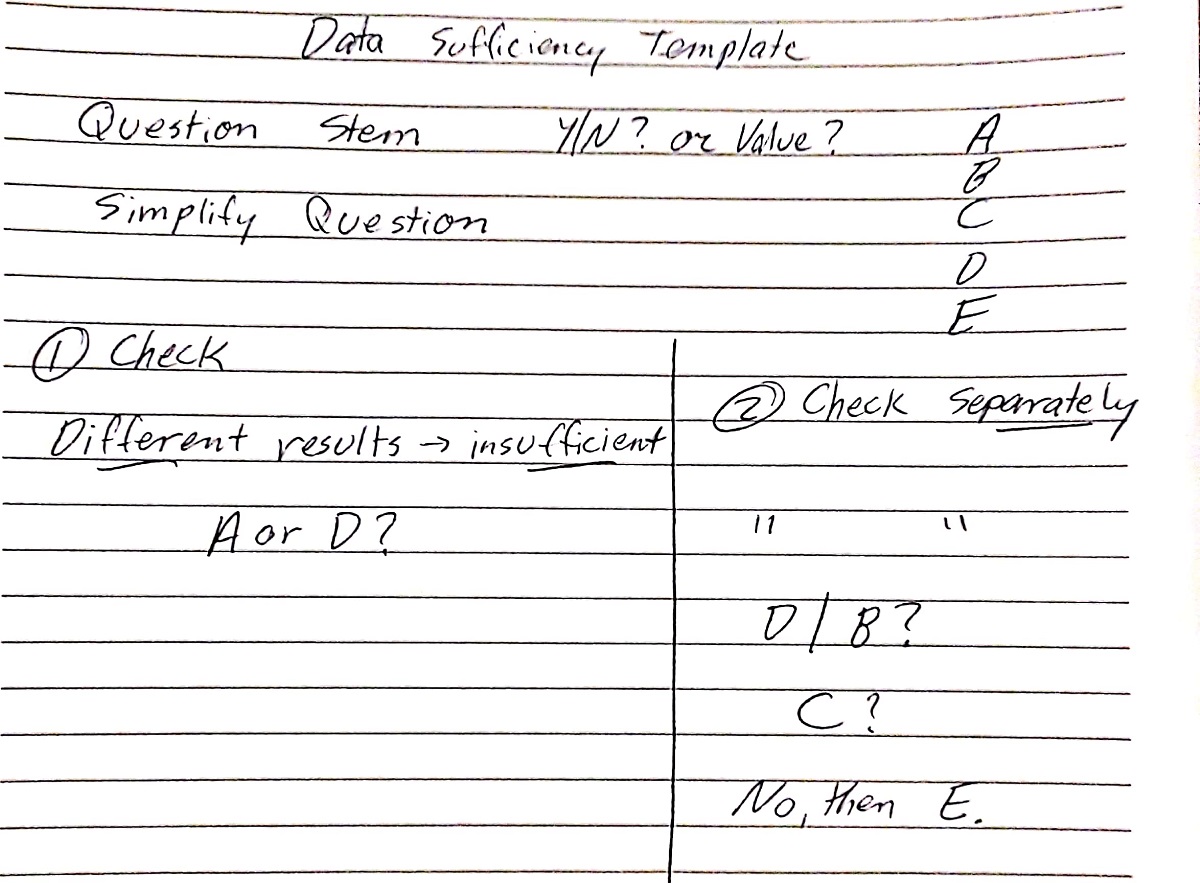For general GMAT prep information, click here.
Overall Strategies and Notes
- Write out ‘A’ for each question with space for B, C, D, E, to use process of elimination explicitly. The small time commitment per question is worth the big time savings on difficult questions when you really need the visual aid to process of elimination.
- Using a time strategy is important to keep on track. A simple time strategy is under the heading for each section below. Must be simple otherwise you are wasting time and energy calculating time.
- Even though the GMAT is an adaptive test, do not try to evaluate your progress based on the difficulty of the questions you see. Don’t freak out if you see an easy question. There are unscored experimental questions interwoven so you may be seeing an easy experimental question. Just answer them right! (Princeton Review)
Strategies by Question Type
The specific categories of verbal questions are straight from the Kaplan GMAT 800 study book.
Verbal Reasoning, 36 questions 65 minutes
Time plan: arrive at question 15, 25, 36 at the 40, 20, 1 minute remaining marks.
-
Critical Reasoning, 7 types ~12 questions
- Numbers and Stats
- Surveys and Studies
- Scope Shifts
- Causation
- Alternative Explanations
- Explain / Paradox
- Odd Man Out
Critical reasoning questions appear on the LSAT as well. “LSAT recycle”
-
Reading Comprehension, 3 types ~12 questions
- Business
- Social Science
- Natural Science
Draw a quick horizontal line for each paragraph of a passage and jot a word or two describing the purpose of each paragraph. This helps organize the information and helps return for reference.
Common error: sometimes GMAT will ask for something that the passage “implied” or “can be inferred.” Sometimes I will ignore the correct answer because I believe I remember it being actually explicitly stated when actually it was only implied. If you think explicitly stated, it has good chance to be right answer, go back and check.
If you don’t understand an answer option at all, don’t pick it just because you can’t find the right answer and you assume you are stupid and don’t understand.
Sometimes correct answers will have a word that is not found in the passage and you have to make a small leap to the answer.
“React” means “take issue with” or “disagree.” Hence “reactionary” movement WRT revolutions et cetera.
Don’t get tired of searching because you can’t eliminate all wrong options. Find the right one!
-
Sentence Correction, 8 types ~12 questions
-
Modifiers
-
Idioms
- “in contrast to” not “in contrast “with”
- “sum lower than” not “sum less than”
-
Parallelism
-
Comparisons
- Comparisons must be grammatically consistent.
- Must be direct comparisons, apples to apples.
-
Verb Tense
-
Subject / Verb Agreement
-
Pronouns
- A pronoun cannot have multiple antecedents to possibly refer to.
-
Expression
-
Sentence Correction Priorities
- Must be grammatically correct.
- Clarity, especially clarity of what pronouns / adjectives / modifiers refer to.
- Succinctness
- Active over passive
- Maintain meaning but sometimes the sentence must become more specific to be clear. More specific is not considered altered meaning and therefore okay.
Choice A is always the unchanged sentence. As soon as there is an error, eliminate A. Even if A is possible, the others are equal possibilities. Favor the better answer, not the unchanged answer.
You can select an answer with a generic noun in place of a pronoun if the sentence should have a noun. E.g. “Jessica” in place of “she.”
A semi-colon can only separate two phrases that can stand as independent and complete sentences. If semi-colon, then a period must work also.
Kaplan GMAT 800 page 161 question 27 says to change the wording because “are bringing” is “unnecessary,” and therefore change to just “bring.” It is grammatically correct but they alter why? Maybe to be more succinct? The top of page 176 says, ” an unnecessary alteration is always wrong.” These seem to contradict.
Be able to identify modifiers and participles.
If 3-4 of the options say almost the same thing, best to pick the most specific because it will likely be considered more clear. This sometimes appears to alter the meaning but more specific is not necessarily considered altered meaning.
Error: Pronoun – noun agreement. On question 65 I selected the pronoun “their” to refer to the country of Turkey. Incorrect.
Subjunctive: 1. Desire / wish, 2. “if” senetences, 3. “that …”
“fewer” and “number of” go with countable objects while “less than” and “amount of” go with non-quantifiable
Quantitative Reasoning (AKA Math), 31 questions 62 minutes
Time plan: arrive at question 12, 22, 31 at the 40, 20, 1 minute remaining marks.
Optimal time per question ~~ 1-3 minutes. Less than one minute, and you should check for a tricky question. More than 3 minutes and you should move on because you are likely doing it wrong. More than 4 minutes, emergency jettison! Cut your losses and move on.
Quantitative “Shortcuts”
These are not really shortcuts, but even though you could solve many of these types of problems by “figuring them out,” you get a higher score by maximizing your time by knowing the rules for these specific items. The following concepts are highly represented on the GMAT:
- Permutations and Combinations, familiarity with the formulas and concepts is critical.
- Double something squared is x4. Double something cubed is x8.
- Remember that square root has a positive and negative result.
- Any number squared is always positive.
- For inequalities, the only time the sign flips is when you multiply (or divide of course) by a negative number.
- Least common multiples, greatest common factors, and prime numbers.
- Division remainders, and remainder tricks.
- Sequences, arithmetic mean, median.
- In any evenly-spaced sequence, mean = median = first + last term / 2.
- Arithmetic mean = sum of sequence / number of terms. GMAT often refers to the sum of a sequence and requires you to recognize that it can be taken as a variable by itself ignoring its component sequence.
- Absolute values
-
Straight Math ~8 questions?
-
Word Problems ~8 questions?
- Pay attention to exactly what question is asking: part vs. part of whole, fraction remaining vs. time remaining at rate to finish, ratio vs. fraction.
- Make a table sometimes for multiple quantities of multiple categories within a group.
- Use very clear variables with lots of subscripts as required!
- Common error: not separating first period cost (or any fixed value) from ongoing cost (or any repeated value).
-
Data Sufficiency ~15 questions?
Integrated Reasoning, 12 questions 30 minutes
(not part of main score, added to test ~2013)
Time plan: arrive at question 4, 8, 12 at the 20, 10, 1 minute remaining marks. Of note also, finish 6 at 15 minutes remaining. The halfway point is hard to ignore as you look at the clock ticking.
Analytical Writing Assessment, 1 question 30 minutes
(not part of main score)


One thought on “GMAT Printable Strategy Sheet”
Comments are closed.